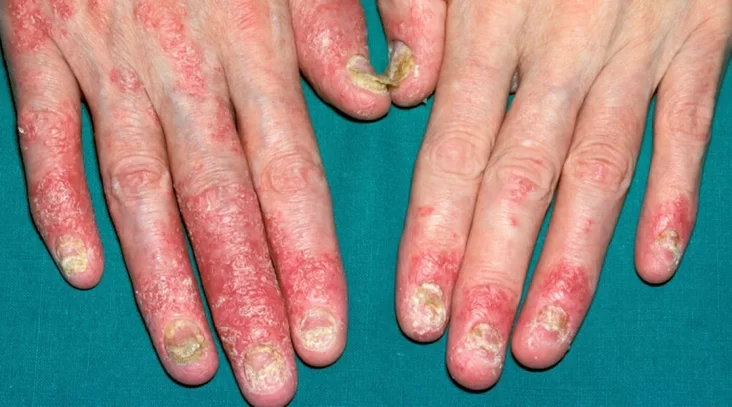Psoriatic arthritis (PsA) is a chronic autoimmune disease that affects millions worldwide. It’s a unique form of inflammatory arthritis that often accompanies psoriasis, a skin condition characterized by red, scaly patches. PsA can impact various joints in the body, causing pain, stiffness, swelling, and reduced mobility. Understanding PsA involves delving into its symptoms, causes, diagnosis, treatment, and management strategies.
What are the five forms of psoriatic arthritis?
Psoriatic arthritis may be classified by a healthcare practitioner based on which joints are affected or which side of your body symptoms appear on. The five kinds of psoriatic arthritis are:
- Distal interphalangeal predominant psoriatic arthritis: This affects the joints at the ends of your fingers and toes (phalanges). It is the most frequent form of psoriatic arthritis that affects the fingernails and toes. Your nails might appear discoloured, flaky, or pitted.
- Symmetric polyarthritis: Polyarthritis affects five or more joints simultaneously. Symmetric polyarthritis affects identical joints on both sides of the body. For example, both your knees and elbows. It is one of the most common forms of psoriatic arthritis.
- Asymmetric oligoarticular psoriatic arthritis: This affects two to four joints on either side of your body—for example, one knee and one elbow. It is the second most frequent type of psoriatic arthritis, following symmetric polyarthritis.
- Spondylitis: Your spine is made up of 33 vertebrae. Spondylitis causes inflammation and other symptoms in the joints that connect your vertebrae. It may also cause pain in your hips and shoulders.
- Arthritis mutilans: This produces significant symptoms in the hands and feet. The inflammation is typically severe enough to cause bone loss (osteolysis). It is the rarest type of psoriatic arthritis. Less than 5% of all psoriatic arthritis patients develop arthritis mutilans.
Symptoms of PsA typically include joint pain, stiffness, and swelling, which can affect any joint in the body. These symptoms may come and go, with periods of flare-ups and remission. Additionally, PsA can lead to inflammation in other areas, such as the eyes, causing conditions like uveitis. Nail changes, such as pitting or separation from the nail bed, are also common in individuals with PsA.
The exact cause of PsA is not fully understood, but it is believed to involve a combination of genetic, environmental, and immune system factors. Certain genes, such as those associated with psoriasis, increase the risk of developing PsA. Environmental triggers like infections or trauma can also play a role in triggering the disease in susceptible individuals. The immune system mistakenly attacks healthy tissues, leading to inflammation in the joints and skin characteristic of PsA.
Diagnosing PsA can be challenging, as its symptoms overlap with other forms of arthritis. A comprehensive evaluation by a healthcare professional, including a physical exam, medical history review, imaging tests like X-rays or MRI, and blood tests to check for markers of inflammation, is typically necessary to confirm a diagnosis.
Treatment for PsA aims to alleviate symptoms, slow disease progression, and improve quality of life. This often involves a combination of medication, lifestyle modifications, and therapy. Nonsteroidal anti-inflammatory drugs (NSAIDs) can help relieve pain and inflammation. Disease-modifying antirheumatic drugs (DMARDs) such as methotrexate are prescribed to suppress the immune system and slow joint damage. Biologic therapies, including TNF-alpha inhibitors and IL-17 inhibitors, target specific components of the immune system involved in PsA.
In addition to medication, lifestyle modifications can also help manage PsA symptoms. Maintaining a healthy weight, exercising regularly to improve joint flexibility and strength, and adopting joint protection techniques can all contribute to better disease management. Physical and occupational therapy can provide tailored exercise programs and assistive devices to support joint function and mobility.
PsA is a chronic condition that requires long-term management and monitoring. Regular follow-ups with healthcare providers are essential to track disease progression, adjust treatment as needed, and address any new symptoms or concerns. Moreover, staying informed about PsA, participating in support groups, and seeking emotional support can help individuals cope with the physical and emotional challenges of living with the condition.
In conclusion, Psoriatic arthritis is a complex autoimmune disease that affects both the joints and skin. While there is no cure, effective management strategies can help control symptoms, improve function, and enhance the quality of life for individuals living with PsA. A comprehensive approach that includes medication, lifestyle modifications, therapy, and ongoing medical care is crucial for successfully managing this chronic condition.

